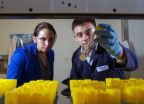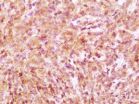(Press-News.org) Amyotrophic lateral sclerosis, also known as Lou Gehrig's disease, is marked by a cascade of cellular and inflammatory events that weakens and kills vital motor neurons in the brain and spinal cord. The process is complex, involving cells that ordinarily protect the neurons from harm. Now, a new study by scientists in The Research Institute at Nationwide Children's Hospital points to a potential culprit in this good-cell-gone-bad scenario, a key step toward the ultimate goal of developing a treatment.
Motor neurons, or nerve cells, in the brain and spinal cord control the function of muscles throughout the body. In amyotrophic lateral sclerosis (ALS), motor neurons die and muscles weaken. Patients gradually lose the ability to move and as the disease progresses, are unable to breathe on their own. Most people with ALS die from respiratory failure within 3 to 5 years from the onset of symptoms.
For the study, published online this month in Neuron, researchers examined a protein involved in transcriptional regulation, called nuclear factor-kappa B (NF-κB), known to play a role in the neuroinflammatory response common in ALS. NF-ƘB has also been linked to cancer and a number of other inflammatory and autoimmune diseases.
Using animal models, the researchers studied disease progression in mice in which NF-ƘB had been inhibited in two different cell types — astrocytes, the most abundant cell type in the human brain and supporters of neuronal function; and microglia, macrophages in the brain and spinal cord that act as the first and main form of defense against invading pathogens in the central nervous system. Inhibiting NF-ƘB in microglia in mice slowed disease progression by 47 percent, says Brian Kaspar, MD, a principal investigator in the Center for Gene Therapy at Nationwide Children's and senior author of the new study.
"The field has identified different cell types in addition to motor neurons involved in this disease, so one of our approaches was to find out what weapons these cells might be using to kill motor neurons," Dr. Kaspar says. "And our findings suggest that the microglia utilize an NF-κB-mediated inflammatory response as one of its weapons."
Inhibiting the protein in astrocytes had no impact on disease progression, so the search for the weapons that cell type uses against motor neurons continues. These preliminary findings also don't tell scientists how or why NF-κB turns the ordinarily protective microglia into neuron-killing molecules. But despite the mysteries that remain, the study moves scientists closer to finding a treatment for ALS.
The search for an ALS therapy has been focused in two directions: identifying the trigger that leads to disease onset and understanding the process that leads to disease progression. Changes in motor neurons are involved in disease onset, but disease progression seems to be dictated by changes to astrocytes, microglia and oligodendrocytes. Some cases of ALS are hereditary but the vast majority of patients have no family ties to the disease. The complexity of the disease and the lack of a clear familiar tie make screening before disease onset nearly impossible, highlighting the importance of slowing the disease, Dr. Kaspar says.
"Focusing on stopping the changes that occur in astrocytes and microglia has clinical relevance because most people don't know they're getting ALS, says Dr. Kaspar, who also is an associate professor of pediatrics and neurosciences at The Ohio State University College of Medicine. "We have identified a pathway in microglia that may be targeted to ultimately slow disease progression in ALS and are exploring potential therapeutic strategies and may have broader implications for diseases such as Alzheimer's and Parkinson's Disease amongst others."
INFORMATION:
Study identifies key player in motor neuron death in Lou Gehrig's disease
2014-03-26
ELSE PRESS RELEASES FROM THIS DATE:
Repeat sternotomy for aortic valve replacement safe option for octogenarian patients
2014-03-26
Beverly, MA, March 26, 2014 – Surgical aortic valve replacement generally improves patients' symptoms and prolongs survival. However, the perceived risk of surgical aortic valve replacement in patients over 80 may result in surgery being denied or a recommendation for alternative therapy. Investigators at the Mayo Clinic challenge the way these patients have been managed. They report that repeat sternotomy in patients over 80 who have previously had coronary bypass graft surgery can be done with low risk. Their findings are published in the Journal of Thoracic and Cardiovascular ...
Prestorage conditioning, diphenylamine improve condition of 'honeycrisp' apple
2014-03-26
EAST LANSING, MI--Since the introduction of 'Honeycrisp' apples in 1991, the variety has become a consumer favorite for its unusual texture and delicious flavor. Honeycrisp has increased in popularity with growers as well; Michigan, New York, and Washington boast significant numbers of 'Honeycrisp' orchards. As the growing area dedicated to the variety has grown, the need to find better methods for improving storage performance has become more important to growers. Because 'Honeycrisp' is very sensitive to low temperatures and can be damaged by controlled-atmosphere conditions, ...
Nitrogen source determined significant for inflorescence development in Phalaenopsis
2014-03-26
TAIPEI, TAIWAN--The Phalaenopsis orchid, also known as the moth orchid, is the most important pot flower in terms of market value in the world's major floriculture markets. Because nitrogen significantly affects the growth and flowering of Phalaenopsis, nitrogen needs during flowering are of particular interest to growers. Researchers Hadi Susilo, Ying-Chun Peng, and Yao-Chien Alex Chang from the Department of Horticulture and Landscape Architecture at National Taiwan University published a study in the Journal of the American Society for Horticultural Science that determined ...
Engineered bacteria produce biofuel alternative for high-energy rocket fuel
2014-03-26
Researchers at the Georgia Institute of Technology and the Joint BioEnergy Institute have engineered a bacterium to synthesize pinene, a hydrocarbon produced by trees that could potentially replace high-energy fuels, such as JP-10, in missiles and other aerospace applications. With improvements in process efficiency, the biofuel could supplement limited supplies of petroleum-based JP-10, and might also facilitate development of a new generation of more powerful engines.
By inserting enzymes from trees into the bacterium, first author and Georgia Tech graduate student ...
Ancient sea creatures filtered food like modern whales
2014-03-26
The animals lived 520 million years ago during the Early Cambrian, a period known as the 'Cambrian Explosion' in which all the major animal groups and complex ecosystems suddenly appeared. Tamisiocaris belongs to a group of animals called anomalocarids, a type of early arthropod that included the largest and some of the most iconic animals of the Cambrian period. They swam using flaps down either side of the body and had large appendages in front of their mouths that they most likely used to capture larger prey, such as trilobites.
However, the newly discovered fossils ...
First ring system around asteroid
2014-03-26
The rings of Saturn are one of the most spectacular sights in the sky, and less prominent rings have also been found around the other giant planets. Despite many careful searches, no rings had been found around smaller objects orbiting the Sun in the Solar System. Now observations of the distant minor planet [1] (10199) Chariklo [2] as it passed in front of a star have shown that this object too is surrounded by two fine rings.
"We weren't looking for a ring and didn't think small bodies like Chariklo had them at all, so the discovery — and the amazing amountof detail ...
Gut metabolism changes -- not stomach size -- linked to success of vertical sleeve gastrectomy
2014-03-26
CINCINNATI—It's not the size of the stomach that causes weight loss after a specific type of bariatric surgery, but rather a change in the gut metabolism, say researchers from the University of Cincinnati (UC), the University of Gothenburg in Sweden and Cincinnati Children's Hospital Medical Center.
The scientists, publishing their results in the March 26, 2014, advanced online edition of Nature, have found that following vertical sleeve gastrectomy, there is a change in bile acids that bind to a nuclear receptor called FXR. In the absence of FXR, the researchers showed, ...
Some breast cancer tumors hijack patient epigenetic machinery to evade drug therapy
2014-03-26
PITTSBURGH, March 26, 2014 – A breast cancer therapy that blocks estrogen synthesis to activate cancer-killing genes sometimes loses its effectiveness because the cancer takes over epigenetic mechanisms, including permanent DNA modifications in the patient's tumor, once again allowing tumor growth, according to an international team headed by the University of Pittsburgh Cancer Institute (UPCI).
The finding warrants research into adding drugs that could prevent the cancer from hijacking patients' repressive gene regulatory machinery, which might allow the original therapy ...
First comprehensive atlas of human gene activity released
2014-03-26
Boston, MA — A large international consortium of researchers has produced the first comprehensive, detailed map of the way genes work across the major cells and tissues of the human body. The findings describe the complex networks that govern gene activity, and the new information could play a crucial role in identifying the genes involved with disease.
"Now, for the first time, we are able to pinpoint the regions of the genome that can be active in a disease and in normal activity, whether it's in a brain cell, the skin, in blood stem cells or in hair follicles," said ...
Brain degeneration in Huntington's disease caused by amino acid deficiency
2014-03-26
Working with genetically engineered mice, Johns Hopkins neuroscientists report they have identified what they believe is the cause of the vast disintegration of a part of the brain called the corpus striatum in rodents and people with Huntington's disease: loss of the ability to make the amino acid cysteine. They also found that disease progression slowed in mice that were fed a diet rich in cysteine, which is found in foods such as wheat germ and whey protein.
Their results suggest further investigation into cysteine supplementation as a candidate therapeutic in people ...



